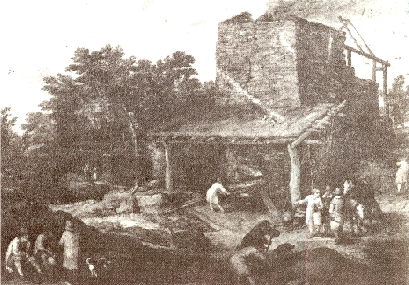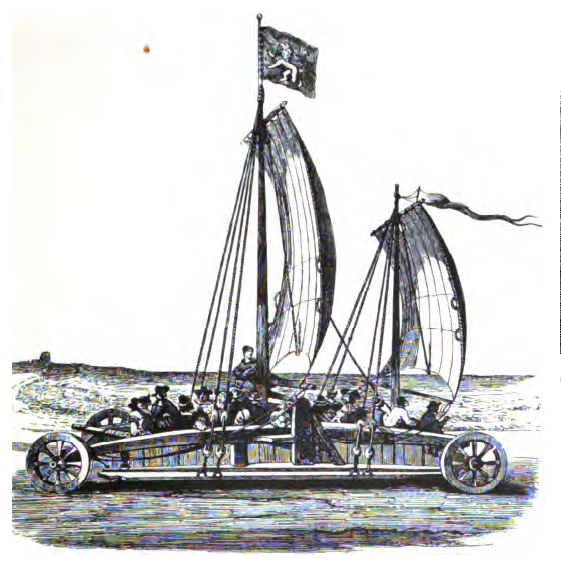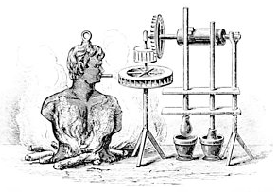100AD
THE TRIP HAMMER, powered by a water wheel, was in widespread use in China, setting a trend for the heavy machinery needed to put motorcycles into mass production.
THOSE CLEVER Chinese were also making paper – just the job for handbooks, gaskets and air filters.
200AD
COMBINATION LOCKS were used in the Roman Empire, which must have made life tough for chariot thieves.

350 AD
ARCHEOLOGICAL evidence is scanty, but there’s a good chance that a water powered sawmill at Hieropolis (in what is now Turkey) featured a crank and conrod.
600AD
TOILET PAPER became available in China, by which time there must have been a hell of a queue at the lavatory. It is still much in demand after fast cornering on wet roads.

800AD
GUNPOWDER WAS invented in China although it was the Europeans who perfected its use for killing people. It was to play a surprising part in the evolution of the internal combustion engine.
THE STREETS of Baghdad were paved with tar, which must have speeded up all those horses and camels no end.

1206
ISMAIL AL-JAZARI, an engineer and mathematician who worked in Diyar-Bakir (in modern-day Turkey) described a pump which featured a piston, conrod and crankshaft to convert rotary motion into linear motion. Do it the other way and you have a reciprocating engine. Other clever chaps had previously made use of cranks in China and Byzantium but Al-Jazari also used wooden templates as patterns, ground in valves with an abrasive paste, understood static wheel balancing, made sandcast metal components and left accurate assembly instructions for 100 mechanical devices.

1346
THE FIRST documented European use of gunpowder as a propellant, at the battle of Crecy. Why is this relevant to motorcycling history? Because guns rely on a rapidly expanding gas to propel an object along an accurately bored cylinder. And that process is at the heart of the petrol engines that propel motorcycles.
1419
Giovanni Fontana, a member of the Arts Faculty at Padua University, descrived a cart which was propelled by its driver pulling on a loop of rope running round a pulley geared to the rear wheels.A couple opf centuries later Johann Hautch of Nuremberg built some carriages to Fontana’s design and word has it the system worked. Mind you, it sounds much harder than walking.
1478
LEONARDO DA VINCI designed the first self-propelled vehicle in history. It was a 1.7×1.5m three-wheeler incorporating coiled springs that were wound up by revolving the wheels backwards, just like a kid’s toy. To deliver power smoothly the design featured a balance wheel, as used in clocks. No seat was shown in the drawings; it seems the cart was designed as a spectacle to be used during festivals and it incorporated a control system using wooden pegs so it would follow a pre-programmed path. A mechanism similar to a differential allowed the turning angle to be pre-set. In 2004 the Museum of the History of Science in Florence, da Vinci’s home town, built the cart to his design and it worked, albeit only for some 40m. In 1974 there was a lot of excitement, particularly in Italy, when a sketch of a bicycle, complete with pedals and drive belt, was discovered on the back of a sheet full of Leonardo’s original sketches. A 16th century conservator had folded this sheet in half and glued it shut. Not because he wanted to rob us of the amazing bicycle, but because he found several doodles of phalluses on the back. The bicycle hadn’t been there when the papers were examined in 1961, just before Italian monks started to restore them, so it seems one of the monks drew a bike among the willies [and that’s not a sentence you see every day].

IRON HAD been made in Britain since Roman times, but at about this time blast furnaces, using bellows to pump in air and increase the temperature, were first set up in the Kentish Weald. By the 18th century this technique spread across the country.

1585
MASTER GUNNER Edward Webbe reported: “Whilst I was remaining prisoner in Turkey I myselfe was there constrained to make a cunning peece of fire work framed in form like to ye Arke of Noy, being 24 yardes high, and eight yardes broad, wherin was placed 40 men, drawen on 6 wheels, yet no man seene, but seemed to goe along, as though it were onely drawen by two Fiery Dragons, in which shew or Arke there were thirteene thousand severall peeces of fire worke.”
1600
MATHEMETICIAN Simon Stevin built two wind-powered carriages for Prince Morris of Nassau; the larger of them managed 42 miles in two hours while carrying 28 passengers. Assuming the prince (who steered it himself) had his family crest engraved on his toy, it’s nice to know there was a Morris on the road, or at least the beach, so long ago. The giant sand yacht is believed to have survived into the 19th century.

1601
GIOVANNI BATTISTA della Porta experimented with steam to create pressure or a vacuum. He was also a hydraulic engineer who delighted in making automata. They were toys, but their construction honed skills that he put to good use in early machinery. Being a man of his times della Porta wrote about everything from earthquakes and lightning to the appliance of magic—but he was one of the pioneers of the scientific approach which led to the Enlightenment, the Industrial Revolution and ultimately to motor cycles.

1606
SPANISH POLYMATH Jeronimo de Ayanz y Beaumont patented a steam-powered system for pumping water out of deep mines. He also worked on a shipboard distillation plant to produce drinking water from seawater, a form of air conditioning to improve the atmosphere in mines, a diving bell and a submarine.

1615
SALOMAN DE CAUS, who had been an engineer and architect under Louis XIII, published a book showing a device similar to della Porta’s.
1625
JOHN MARSHALL petitioned for a patent for “a new invention of a cart of 15cwt to carry a great burden without help and guided but by himself.” No details survive but it must have been more than a fantasy as Marshall was invited to present his petition directly to Charles I.
1629
ITALIAN GIOVANNI Branca published designs for a number of ingenious mechanical contrivances, including a steam-engine in which the steam issuing from a boiler spun the vanes of a horizontal wheel. The same principle had been used by Hero of Alexandria more than 1,500 years before, but unlike Hero Branca suggested practical uses for his design.

1644
AN ANONYMOUS Englishman built a man-carrying clockwork carriage in Paris. It worked well on smooth ground but the labour involved in winding up the springs was so great that the project was abandoned.
1650
ALLDAYS & ONIONS would begin to build motor cycles in 1898 but the firm’s roots go back to the launch of Onions Co in 1650 (Alldays didn’t get started till 1720). Alldays & Onions riders might still enjoy telling Harley riders that their marque is half a century older than their country.

JOHANN HAUTSCH of Nuremberg built a horseless carriage able to carry several passengers at “2,000 paces an hour” thanks to a couple of stalwart chaps turning a winch driving the rear axle via a gear train. The dragon’s head spouted water “for the purpose of clearing the way in a crowd”; the dragon’s eyes moved to and fro “with great rapidity” and angels on each side of the carriage “sounded their trumpets”. It was sold to the Crown Prince of Sweden and Hautsch made another for the King of Denmark.

1655
EDWARD SOMERSET, 2nd Marquis of Worcester, published a selection of his inventions including an innovative steam pump. He built what was (probably) the first industrial-scale steam engine into the side of Raglan Castle, his family home in South Wales. He fought for the Royalist cause during the Civil War and legend has it that when Parliamentarian forces arrived at the castle to demand its surrender, the order was given to start the steam pump. As it hissed and roared into life, someone shouted “The lions have got loose!” The Roundheads, knowing there was a menagerie at the castle, went home. The New Model Army were clearly sensitive souls.

1659
BURIED IN THE Philosophical Transactions of the Royal Society is an obscure report entitled A Description of a Well and Earth in Lancashire taking Fire by a Candle Approached to it. Imparted by Thomas Shirley, Esq, and Eye-witnesses. It starts: “About the latter end of February, 1659, returning from a journey to my house in Wigan, I was entertained with the relation of an odd spring situated in one Mr Hawkley’s grounds, about a mile from the town, in that road which leads to Warrington and Chester. The people of this town did affirm, that the water of this spring did burn like oyle; into which error they suffered themselves to fall for want of due examination of the following particulars. For when I came to the said spring, (being five or six in company together,) and applied a lighted candle to the surface of the water, ’tis true there was suddenly a large flame produced, which burnt vigorously. I began to examine what I saw; and observed that the water at the burning place did boyle, and heave like water in a pot upon the fire, though my hand put into it perceived it not so much as warm. This boyling I conceived to proceed from the eruption of some bitumous or sulphureous fumes, considering this place was not above thirty or forty yards distant from the mouth of a coal-pit there… Then applying my hand to the surface of the burning place of the water, I found a strong breath, as it were a wind, to bear against my hand. Then I caused a dam to be made, and thereby hindering the recourse of fresh water to the burning place, I caused that which was already there to be drained away; and then applying the burning candle to the surface of the dry earth at the same point where the water burned before, the fumes took fire, and burned very bright and vigorous. The cone of the flame ascended a foot and a half from the superfices of the earth. I then caused a bucket-full of water to be poured on the fire, by which it was presently quenched, as well as my companions’ laughter was stopped, who began to think the water did not burn…” Thomas Shirley had discovered a new fuel; we call it methane and you can run an engine on it.
1663
Robert Hooke (who, of course, was born on my adopted home, the Isle of Wight), newly elected a Fellow of the Royal Society, drew up plans for a machine with which one could “walk upon the land or water with swiftness, after the manner of a crane”.
1666
JEAN-BAPTISTE Colbert, a minister of French King Louis XIV, established the Academy of Sciences at Paris with a brief of “discovering and perfecting a new source of power capable of effecting a dramatic human advance”. He recruited multi-talented Dutch inventor Christian Huygens whose plans included “research into the power of gunpowder of which a small portion is enclosed in a very thick iron or copper case. Research also into the power of water converted by fire into steam.”
1668
ERDINAND VERBIEST, a Flemish Jesuit missionary in China, designed a toy for the young Chinese emperor Enkh Amgalan Khaan which was, probably, the first steam-powered vehicle in the world. It was 650mm long; steam generated in a spherical boiler was directed at a simple turbine, much like a water wheel, which drove the front axle via a vertical spindle. Another orifice in the boiler was fitted with a reed to imitate the song of a nightingale. The large fifth wheel could be set at an angle to make the toy steamer go in circles.

1672
CHRISTIAN HUYGENS worked with German diplomat Gottfried Leibniz and Frenchman Dennis Papin to modify an air pump into an engine capable of extracting energy from burning gunpowder. It was the first engine to feature a cylinder and piston. Gunpowder was ignited in the cylinder, expelling the air through check valves, and leaving, after cooling, a partial vacuum. The pressure of the atmosphere then drove a piston down to the bottom of the vessel, lifting a weight or doing other work. After a decade’s worth of experimenting Huygens reported that by burning a dram (2g) of gunpowder, in a cylinder 8ft high and 18in in diameter, his engine could raise seven or eight boys (or about 1,100lb) into the air.

1675
SIR SAMUEL MORLAND patented a “plunger pump” and was granted a Royal Warrant granting him 14 years’ exclusive use of his invention for raising “water out of pits to any reasonable height by the force of air and powder conjointly”. It seems he was working along the same lines as Huygens.
1678
JEAN DE HAUTEFEUILLE also proposed the use of gunpowder to obtain power by using the partial vacuum formed as gases cooled following combustion. His engine was designed to raise water from a reservoir.
PROFESSOR VEGELIUS of Jena was said to have constructed a spring-powered mechanical horse clad in horse skin. It worked, too, with a range of four ‘German miles’ a day (just under 19 miles). It’s not known how often the prof had to dismount and wind up his metallic nag.
1687
GRAVESANDE’S NATURAL Philosophy envisaged a carriage propelled by a jet of steam – effectively a rocket. The secret lies in the book’s subtitle: An Introduction to Sir Isaac Newton’s Philosophy (the third of Sir Isaac’s laws of motion says that to every motion there is an equal and opposite reaction). It’s unlikely that the boiler would have generated enough pressure to move the wagon which, considering its lack of steering or brakes, was definitely A Good Thing. Cool idea though, and the concept is sound. In 1730 the Admiralty tried propelling a ship by firing guns from the stern and it worked – but it took 30 barrels of expensive gunpowder to move 10 really NOISY miles. In due course rockets would propel motor cycles.

1690
DENNIS PAPIN designed an engine with a piston and cylinder in which steam replaced the gunpowder charge of Huygens’s cylinder, creating a more complete vacuum under the piston to take better advantage of atmospheric pressure. He also envisaged using his engine to drive a boat via rotary paddles.

1698
THOMAS SAVERY introduced a steam pump he called the ‘Miner’s Friend’. Savery was granted an exclusive patent which would have given him control of any steam-powered device Papin might invent in England. One US source claims: “The early history of the invention of the steam engine shows without doubt that the British Royal Society, including Isaac Newton personally, deliberately prevented the industrial and naval applications of steam power for nearly 100 years. In fact, the Royal Society was so intent on burying Denis Papin’s 1690 invention of a paddle-wheel-driven steamship, worked out in collaboration with Gottfried Leibniz, that it stole his work, and created a mythical story of how two British ‘Newtonian’ heroes, Savery and Newcomen, invented the steam engine, for the sole purpose of raising water from coal mines – a myth that has persisted in the history books until today.”

